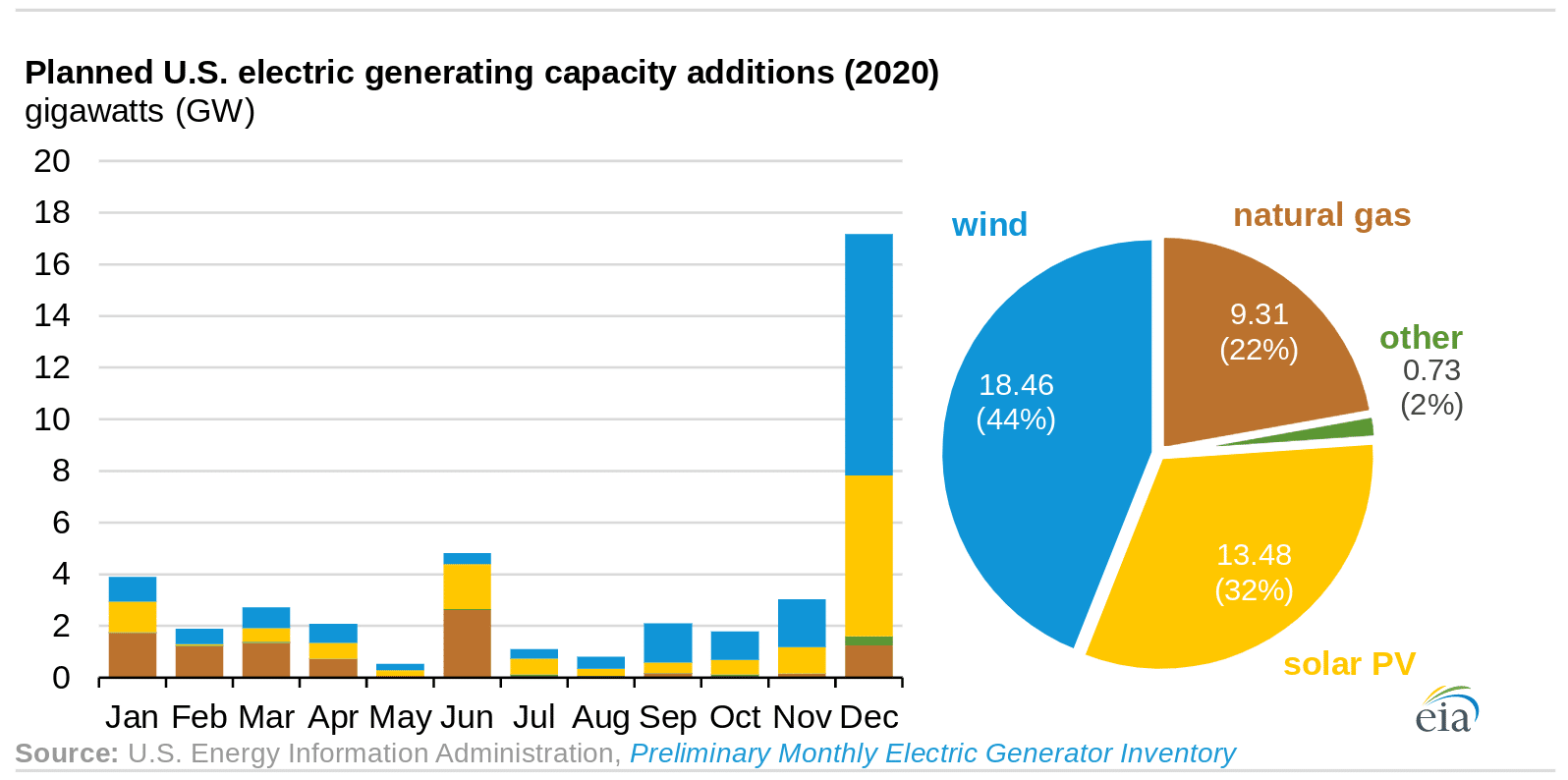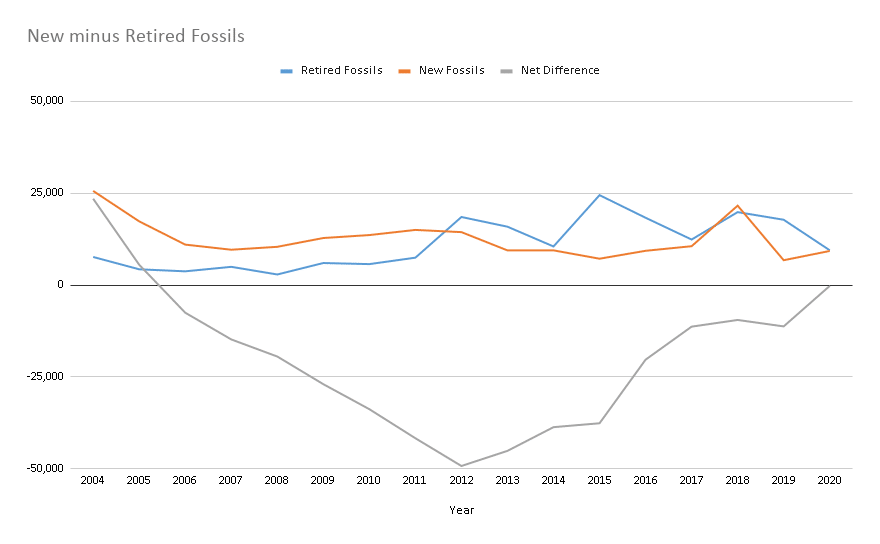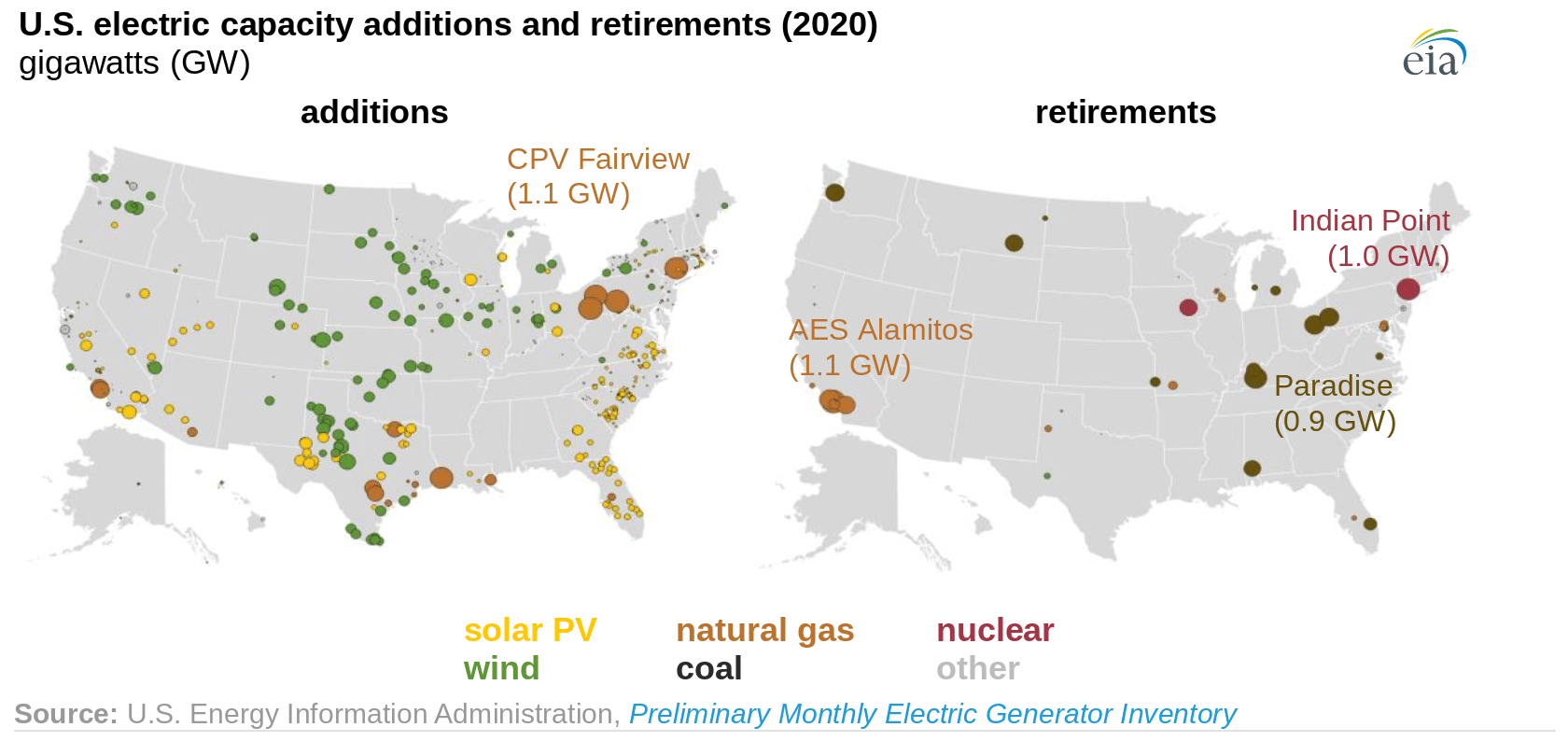Sometime in 2006, the generating capacity of fossil fuels in the United States peaked.
Since then, more fossil-fueled generation has been retired (mostly coal) than has been built. In 2020, the Energy Information Administration (EIA) claims this pattern will repeat — with 32 GW of new wind and solar, 9.3 GW of new gas and 9.5 GW of retired coal and gas projected.

The EIA’s projections claim that the new gas plants are 6.7 GW of combined-cycle facilities and 2.3 GW of combustion-turbine plants, with more than 70% of these additions in Pennsylvania, Texas, California, and Louisiana. There are zero coal plants planned in the United States in 2020 and beyond.
EIA claims that gas units that came online in the 1950s or 1960s will be the majority retired, projecting 3.7 GW of closures with 2.2 GW of that volume coming from three California plants — Alamitos, Huntington Beach, and Redondo Beach. Coal will once again lead retirements, with projections ranging from 5.8 GW per the EIA, and up to 8 GW expected to retire per reporting by S&P Global Market Intelligence.
The combination of these additions and retirements suggests between 200 MW and 2.3 GW of total fossil fuel retirements.

The grey line in the chart shows the net difference between the new volume and the old volume. Including all of 2006, 188 GW of new fossil generation has been installed, while 182 GW of fossil generation has been retired.
Importantly, U.S. electricity generation within this time period has stayed flat since approximately 2007. With the significant volumes of wind and solar that has been built since then, and the falling capacity factors of fossil generation – it’s clear that wind and solar are replacing fossil fuels, and helping to decarbonize the power grid.
In 2019, it was suggested that the power grid emitted 10% lesser emissions than the prior year. And yes, while this was mostly accomplished because of gas replacing coal – the fact that greater than 11 GW of net fossil fuel retired in 2019 means that the electricity had to come from somewhere.

The EIA also buried, along with this author, an amazing lede: the U.S. is projecting a record setting volume of solar to be deployed. This will be made up of 13.4 GWac of utility scale and 5.1GWac of residential solar power. The 18.5 GWac total, with a standard 1.3:1 DC to AC ratio suggests 24 GWdc of solar power will be installed in 2020 — this will blow away the 2016 record.
This content is protected by copyright and may not be reused. If you want to cooperate with us and would like to reuse some of our content, please contact: editors@pv-magazine.com.








That is what EIA, IEA have always done, projected past into the future and why they are normally wrong over 2 yrs out or more.
Now finally they have to say more RE because that has been the trend vs 15 yrs ago it was more coal right before coal started dropping.
Anyone building almost any FF plant in the face of lowering FF generation demand and RE lower costs taking over demand, is not being fiscally smart.
The main thing for the future in combustion is CCGTs run on RE fuels for backup and home, building, business CHP also on RE fuels.
They, TECO wants to convert a coal plant to NG but by the time it gets built, it’ll be obsolete as solar cuts the power peak from the afternoon into an hour before sunset until an hr after sunset, just like
California, no need for it.
I have been tracking some of the EIA data. The capacity factor for coal in the first 10 months of 2019 has dropped to 48.06% compared to 53.49% in 2018. This includes two months below 40% for the first time. And drops of 11%, 5.4% and 9% during the June, July and August summer months.
Last year EIA projected 4GW of coal retirement for 2019 and ended up with 15GW or so. There were 11GW of retirements that weren’t pre-announced before the start of the year – so sudden retirements. I expect more of these to come. Especially as more solar gets installed.
The coal plants in Texas had a windfall last year during the August heatwave and got enough $$ to probably justify running them again this year. I expect this year or next they will suffer as ERCOT has more solar come on-line to help with the summer peak. ERCOT had nearly 7,000GWh more electricity produced in 2019 than 2018. This was offset by 8,000GWh more of wind and solar. They also had 15,400GWh less coal based electricity which was mostly offset by gas.
Solar is going to be a coal killing machine.
🙂
John, great analysis. Ercot’s uniqueness has always been interesting to study, never more so than now with it’s razor thin reserve margins and solar blossoming.
Thanks for the information